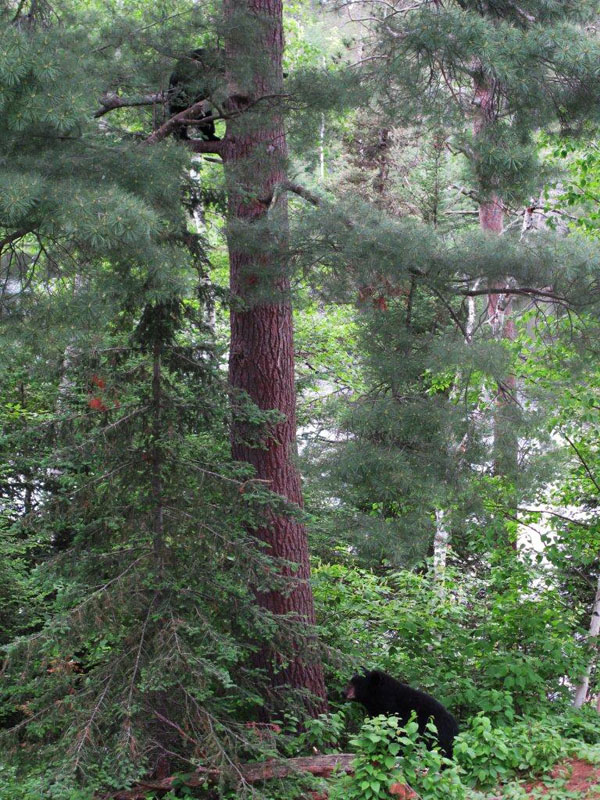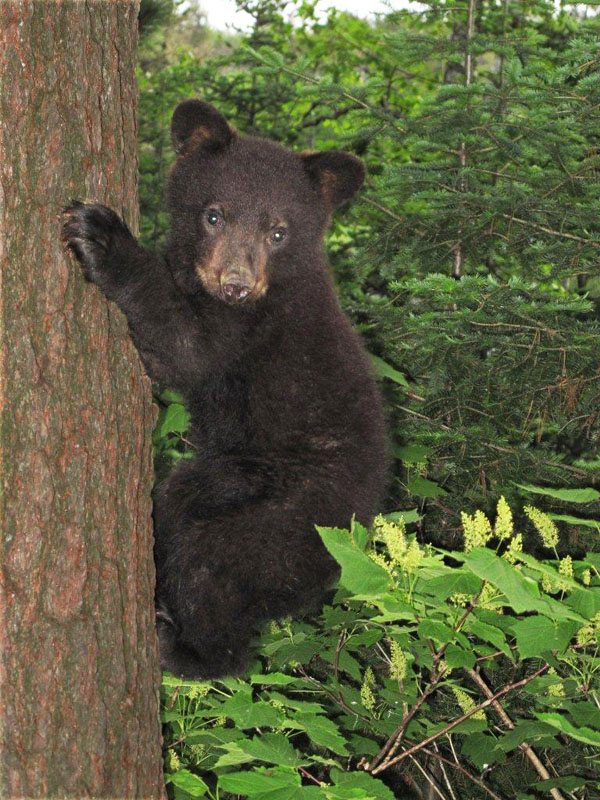Bow and cubs
 Yesterday, Bow treated us to a display of vocalizations and body language that most people misunderstand. Nervous displays by black bears are generally called threats in the terminology of classical behaviorists. Behavior is discussed in terms of threats, dominance, submission, aggression, boldness, etc. We don’t see that. We see nervousness, apprehension, anxiety, and fear. We believe a new vocabulary is needed for describing black bear behavior and are considering writing a book on the language of bears. This book is probably more important than the book Lynn started about his life with bears. It would be a useful guide to understanding bear vocalizations and body language and would likely save the lives of many bears that are routinely shot out of fear or to protect public safety.
Yesterday, Bow treated us to a display of vocalizations and body language that most people misunderstand. Nervous displays by black bears are generally called threats in the terminology of classical behaviorists. Behavior is discussed in terms of threats, dominance, submission, aggression, boldness, etc. We don’t see that. We see nervousness, apprehension, anxiety, and fear. We believe a new vocabulary is needed for describing black bear behavior and are considering writing a book on the language of bears. This book is probably more important than the book Lynn started about his life with bears. It would be a useful guide to understanding bear vocalizations and body language and would likely save the lives of many bears that are routinely shot out of fear or to protect public safety.
What did we see yesterday? Bow was traveling with her two roly-poly cubs when they came across big Loppy. He was foraging peacefully, but Bow gave a quiet expression of anxiety and the cubs scampered to the top of a big white pine (male pictured on right). Bow repeatedly walked toward Loppy (who ignored her) and then stomp-walked back to the base of the white pine. Stomp-walking is a stiff-legged walk where a bear stomps each foot, especially the front feet, into the ground, sliding each foot slightly forward on the ground with each step. We believe there are undiscovered scent glands on black bears’ feet, probably between the toes, and that the sliding leaves scent on vegetation underfoot.
 Eventually, Loppy came over to check out Bow, and she climbed 20-25 feet up (picture above). She blew, slapped the trunk, and clacked her teeth. Loppy was unimpressed. We had long considered clacking teeth to be a threat until we saw a bear almost fall out of a tree, grab on quick, and clack her jaws. There was nothing around to threaten. We plugged fear into the interpretation of clacking teeth and it fit our observations better. No bear followed up with an attack. Loppy eventually left. Lynn walked over to Bow’s tree. She continued her blowing and clacking, now mixing it with huffing. None of it was directed toward Lynn. Bow was looking around as she expressed herself, with most attention in the direction Loppy had disappeared. Huffing meant she was getting over her fear and considering coming down, which she did shortly. The mixture of blowing, clacking, and huffing showed conflicting drives. Huffing is generally considered a threat by most, but we have always seen it in a context of getting over fear—like when a fleeing bear slows down and stops, when a nervous bear is about to climb down a tree, or a bear that has had an encounter is about to resume feeding.
Eventually, Loppy came over to check out Bow, and she climbed 20-25 feet up (picture above). She blew, slapped the trunk, and clacked her teeth. Loppy was unimpressed. We had long considered clacking teeth to be a threat until we saw a bear almost fall out of a tree, grab on quick, and clack her jaws. There was nothing around to threaten. We plugged fear into the interpretation of clacking teeth and it fit our observations better. No bear followed up with an attack. Loppy eventually left. Lynn walked over to Bow’s tree. She continued her blowing and clacking, now mixing it with huffing. None of it was directed toward Lynn. Bow was looking around as she expressed herself, with most attention in the direction Loppy had disappeared. Huffing meant she was getting over her fear and considering coming down, which she did shortly. The mixture of blowing, clacking, and huffing showed conflicting drives. Huffing is generally considered a threat by most, but we have always seen it in a context of getting over fear—like when a fleeing bear slows down and stops, when a nervous bear is about to climb down a tree, or a bear that has had an encounter is about to resume feeding.
On the ground with Lynn lying a few feet away, Bow was calm again although her cubs remained high in the tree for another 15 minutes. Finally, they, too, descended, and the tension from the encounter with big Loppy was gone.
Video of Jo nursing her lone cub on June 11 is posted at http://www.youtube.com/watch?v=P1Rludj5tzM.
Thank you for all you do.
—Lynn Rogers and Sue Mansfield, Biologists, Wildlife Research Institute and North American Bear Center
